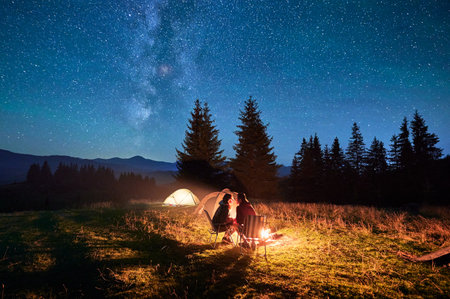Introduction: Embracing the Great Indian Outdoors
India’s vast and diverse landscapes are a dream come true for those who crave adventure and seek to break free from their daily routines. From the misty Himalayas in Himachal Pradesh to the sun-kissed beaches of Goa, and from the dense forests of Madhya Pradesh to the tranquil backwaters of Kerala, camping in India offers an exhilarating blend of nature and culture. For many Indian campers, every journey is not just about escaping into the wilderness—it’s about forging new friendships, discovering local traditions, tasting authentic cuisines cooked over a campfire, and finding oneself under the stars. As more Indian bloggers and YouTubers document their camping escapades, they inspire a wave of explorers eager to set out on their own expeditions. But with this surge of enthusiasm comes a strong sense of responsibility—ensuring that every outdoor adventure is both fun and safe. In this spirit, let’s dive into essential camping safety tips curated by India’s top content creators, so you can embrace the wild while respecting its challenges.
2. Getting Ready: Essential Preparations for Safe Indian Camping
Planning a camping adventure in India is not just about packing your backpack and heading out. According to seasoned Indian bloggers and YouTubers, meticulous preparation ensures both excitement and safety. The country’s vast geography and diverse cultures demand attention to unique local details before setting up camp.
Choosing the Right Campsite
Begin by researching campsites that are known for their security and accessibility. Always check user reviews on Indian travel forums like Tripoto or Vloggers’ recommendations on YouTube. Prioritize locations with clear signage, accessible emergency services, and proximity to villages, which can be helpful in case of unexpected events.
Checklist for Selecting Indian Campsites
| Criteria | Why It Matters |
|---|---|
| Accessibility | Ensures easy entry/exit, especially during monsoon season or emergencies. |
| Water Source | Availability of clean water is vital; avoid stagnant sources due to mosquito-borne diseases. |
| Local Reputation | Avoid sites with reports of wildlife encounters or local disputes. |
| Permission Status | Verify if the site requires permits or permission from local authorities or forest departments. |
| Cultural Sensitivity | Avoid camping near temples, sacred groves, or tribal lands without explicit consent. |
Gathering Necessary Permits and Permissions
Many Indian forests and hill stations require official permits for overnight stays. Visit the district forest office website or approach local police stations for up-to-date requirements. In some states, digital applications are available via government portals like Parivahan or state tourism websites. Always carry physical copies of permits and respect any restrictions imposed by local panchayats or tribal councils.
Packing According to Indian Weather & Wildlife Conditions
India’s unpredictable weather—from Himalayan chills to humid coastal nights—calls for smart packing. Refer to reliable weather apps like IMD or AccuWeather before departure. Additionally, follow these blogger-approved essentials:
| Packing Item | Why It’s Important in India |
|---|---|
| Mosquito Nets & Repellent | Dengue and malaria are concerns in many regions. |
| Rain Gear (Poncho/Umbrella) | Sporadic showers occur even outside monsoon months. |
| Thermal Wear & Blankets | Nights can get surprisingly cold in deserts and hills. |
| Torch/Headlamp with Extra Batteries | No power supply in remote campsites; wildlife safety at night. |
| Bamboo Stick/Whistle | Useful deterrents against monkeys or stray dogs in rural areas. |
Respecting Local Traditions & Customs
Cultural awareness is crucial. Some regions observe strict rituals or festivals where outsiders’ presence may be restricted. Connect with locals through platforms like Couchsurfing India or simply interact respectfully at the village level. Avoid loud music, alcohol consumption in public, and always dress modestly, especially in conservative states.
Blogger Tip: “When in doubt, ask!”
This simple advice from Indian adventure YouTubers goes a long way—whether you’re seeking directions, advice on wildlife movement, or clarity on local customs. Respecting both nature and people ensures your camping experience is safe, memorable, and welcomed by the communities you encounter.

3. Staying Safe with Food and Water: Indian Camp Cuisine Tips
Indian campers know that food and water safety is not just about health—it’s deeply connected to culture, tradition, and respect for nature. Indian bloggers and YouTubers consistently stress the importance of mindful preparation when it comes to meals and hydration outdoors.
Smart Food Storage in Indian Conditions
With temperatures soaring in many parts of India, keeping perishable foods safe is crucial. Use insulated iceboxes or coolers to store dairy, paneer, and cooked sabzis. For longer trips, opt for dry snacks like chivda, roasted makhana, or the ever-reliable thepla. Bloggers recommend always carrying reusable containers and zip-lock bags to keep your food protected from insects and animals—especially monkeys or stray dogs which are common at popular Indian camping spots.
Purifying Water—A Non-Negotiable
Safe drinking water is a top priority. Most Indian adventurers bring portable water filters or boil water before use. If you’re near streams or rivers, purification tablets are handy. Many YouTubers also advise carrying homemade nimbu pani (lemon water) concentrates or ORS sachets to combat dehydration during hot weather treks.
Respecting Dietary Choices & Religious Practices
Cultural sensitivity goes a long way at Indian campsites. Always keep vegetarian and non-vegetarian items separate, respecting the dietary habits of fellow campers. During festivals like Navratri or Ramadan, pack suitable fasting-friendly foods such as fruits, nuts, or sabudana khichdi. Avoid alcohol and meat at sacred sites or when camping near temples and shrines—a common practice recommended by local outdoor enthusiasts. By honouring these customs, you not only stay safe but also build camaraderie with your group.
4. Wildlife Awareness: Coexistence and Protection
India’s wilderness is home to an incredible diversity of creatures—from playful monkeys in the Western Ghats to elusive snakes in the Aravallis, and majestic elephants across the forests of Karnataka and Kerala. Indian bloggers and YouTubers consistently highlight that camping safety isn’t just about protecting yourself—it’s also about respecting and preserving the natural world around you. Here’s how to camp responsibly amidst India’s unique wildlife:
Essential Wildlife Coexistence Tips
| Animal Encountered | Key Precautions | Protective Actions for Campers | How to Avoid Harming Wildlife |
|---|---|---|---|
| Monkeys | Do not feed them; secure all food items. | Use monkey-proof containers; keep distance. | Avoid leaving food scraps or wrappers behind. |
| Snakes | Check shoes/bedding before use; avoid tall grass at night. | Wear sturdy boots; carry a torch after dark. | Do not provoke or attempt to handle snakes. |
| Elephants | Camp away from known elephant corridors. | Stay alert for warning signs (broken branches, dung). | Respect their space—never try to approach or photograph too closely. |
| Bears/Leopards (Himalayas) | No food inside tents; set up camp near others if possible. | Hang food from trees if safe to do so; make noise when moving around at dusk/dawn. | Avoid littering and minimize scents that attract animals. |
Cultural Wisdom from Indian Outdoors Enthusiasts
- Sacred Respect: Many regions consider certain animals sacred. Follow local customs—if villagers warn you about a specific animal, take it seriously.
- Nature-Friendly Gear: Use eco-friendly soaps and cleaners to avoid polluting water sources that wildlife depend on.
- No Fireworks or Loud Music: Indian vloggers advise against these as they disturb animals’ natural behaviors and can cause panic or aggression.
Packing List for Wildlife-Safe Camping in India
- Torch/headlamp with extra batteries (for night visibility)
- Biodegradable waste bags (for responsible trash disposal)
- Airtight containers for storing food
- Nontoxic insect repellent (avoid harming beneficial insects)
- Pocket guide for identifying local wildlife (many Indian campers recommend this!)
Your Adventure, Your Responsibility
The wild heart of India is best explored with both curiosity and caution. By adopting these practices, you protect yourself while ensuring that India’s treasured wildlife continues to thrive alongside adventurous souls like you. Remember—true adventure means leaving no negative trace behind!
5. Emergency Prep: Indian Bloggers’ Go-To Safety Essentials
Must-Have Safety Gear for Indian Campers
Top Indian outdoor influencers repeatedly highlight the importance of carrying the right gear to handle any emergency in the wild. Their essential recommendations include a high-quality torch (preferably rechargeable), a sturdy Swiss knife, and a loud survival whistle. Many suggest opting for solar-powered lanterns due to unpredictable electricity supply at remote Indian campsites. A lightweight but robust power bank and a fully charged mobile phone are non-negotiable for connectivity, especially in hilly regions like Himachal or Uttarakhand where network coverage can be patchy.
First-Aid Kit: What Should Be Inside?
According to experienced Indian bloggers, your first-aid kit should be tailored for local conditions. Start with antiseptic cream (like Dettol or Savlon), bandages, sterile gauze, painkillers (such as Crocin or Combiflam), and anti-allergy tablets (Cetirizine is popular). Since insect bites are common, include mosquito repellent creams like Odomos and anti-itch ointments. For those venturing into forested areas, carrying an anti-snake venom kit is strongly advised by seasoned YouTubers. Don’t forget oral rehydration salts (ORS) to combat dehydration during hot Indian summers.
Emergency Protocols: Influencer-Approved Steps
Indian content creators stress the need to always inform a trusted friend or family member about your exact campsite location before heading out. They recommend downloading offline maps (Google Maps or MapMyIndia) and marking safe exit routes. If you’re camping with a group, set up a basic signal system using torches or whistles for quick communication. In case of wildlife encounters—a real possibility in India’s national parks—avoid sudden movements, maintain silence, and slowly back away while facing the animal. Finally, keep emergency helpline numbers saved on your phone; many influencers advise memorizing 112 (India’s pan-emergency number) and nearby hospital contacts.
Pro Tip from Adventure Vloggers
Several top Indian YouTubers swear by keeping laminated copies of identity proofs and emergency contact details in your backpack—essential if you lose your wallet or need help from local authorities. Always carry some cash in small denominations since digital payments may not work in remote locations.
Your Adventure Awaits—Be Prepared!
Packing smart and following these influencer-endorsed safety protocols ensures that every camping trip across India’s diverse landscapes is not only thrilling but also secure.
Respecting Nature and Culture: Responsible Camping Practices
Embracing Waste Management: Leave No Trace Behind
One of the most repeated tips from Indian bloggers and YouTubers is the importance of managing waste responsibly while camping. In India’s diverse landscapes, whether you are pitching a tent in the Western Ghats or camping by a Himalayan river, it is crucial to carry reusable bags, segregate your waste, and always pack out what you bring in. Many outdoor enthusiasts recommend carrying a small trash bag and using biodegradable products to reduce your ecological footprint. Burning or burying non-organic waste is highly discouraged, as it can harm local flora and fauna.
Respecting Local Customs: Blend In, Don’t Stand Out
India’s cultural tapestry is unique—each region has its own traditions and social norms. Indian vloggers suggest doing a bit of research about the local community before your trip. Dress modestly, avoid public displays of affection, and always ask before taking photographs of people or sacred spaces. If you’re camping near tribal areas or villages, greet elders respectfully and be mindful of religious sentiments. This not only ensures your safety but also builds goodwill with locals who may offer valuable advice or assistance.
Community Interactions: Building Trust Through Sensitivity
Camping in India often brings opportunities for close interactions with local communities. Influencers stress the value of buying supplies from village shops, hiring local guides, and participating in regional festivals if invited. Sharing stories around a bonfire or learning a few words in the local language can transform your adventure into an enriching cultural exchange. Always seek permission before entering private lands, and thank hosts for their hospitality.
Eco-Friendly Habits: Protecting India’s Natural Heritage
Eco-conscious camping is a growing trend among Indian outdoor creators. Use solar-powered lights instead of disposable batteries, opt for organic toiletries that won’t pollute rivers or soil, and avoid making loud noises that could disturb wildlife. When making campfires, use deadwood rather than chopping fresh branches, and extinguish fires completely before leaving. Many bloggers highlight the satisfaction of giving back to nature by participating in clean-up drives or planting native saplings during your journey.
By integrating these responsible practices recommended by Indian bloggers and YouTubers, campers not only ensure their own safety but also contribute to preserving India’s rich natural and cultural heritage for future generations.


